1997 CADILLAC ELDORADO tow
[x] Cancel search: towPage 26 of 361
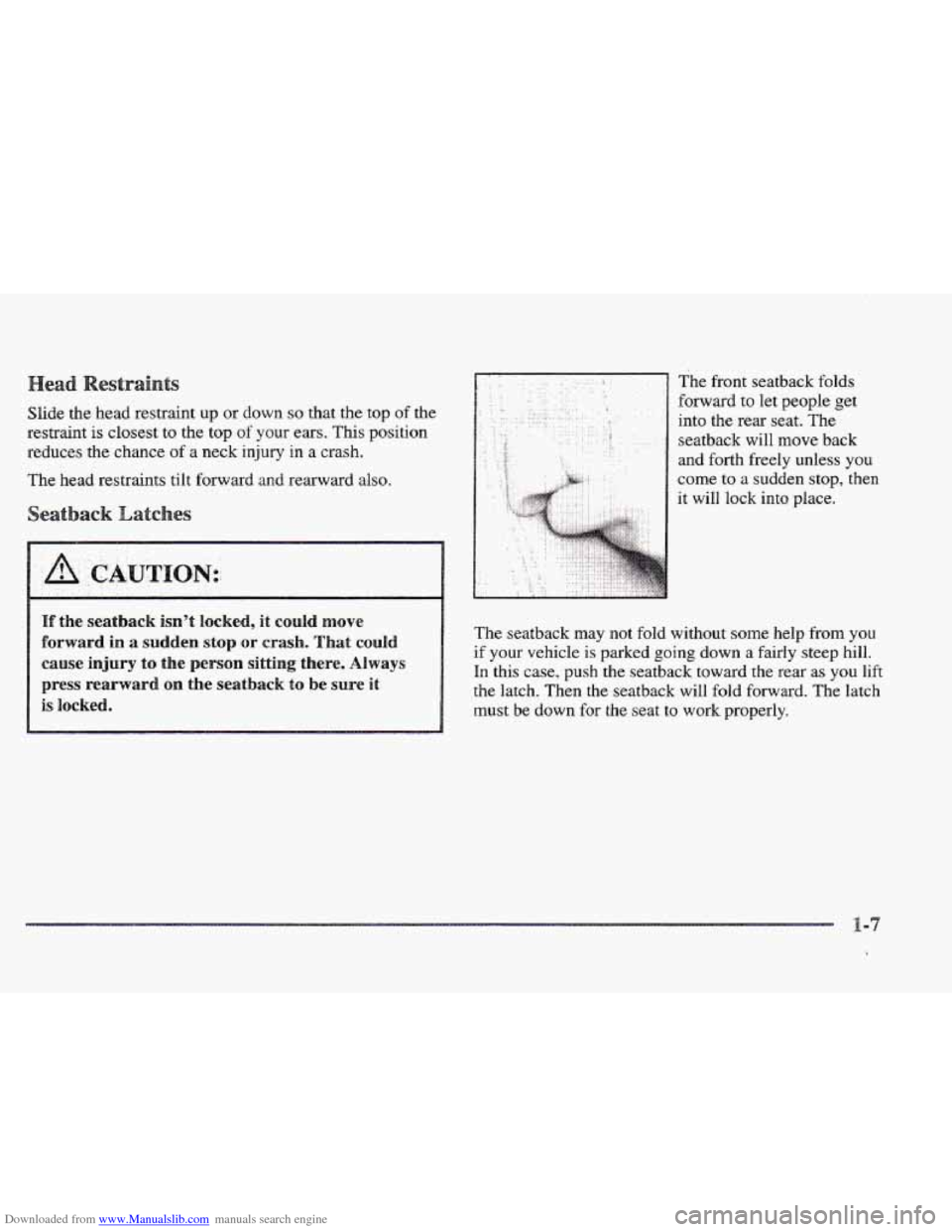
Downloaded from www.Manualslib.com manuals search engine s
Slide the head restraint up or down so that the top of the
restraint is closest to the top
of your ears. This position
reduces the chance of
a neck injury in a crash.
The head restraints tilt forward
and rearward also.
If the seatback isn9t locked, it could move
forward in a sudden stop or crash. That could
cause injury to the person sitting there. Always
press rearward on the seatback to be sure it
is locked.
The front seatback folds
forward to let people get
into the
rear seat. The
seatback will
move back
and forth freely unless you
come to
a sudden stop, then
it
will lock into place.
The seatback may not fold without some help from you
if your vehicle is parked going down a fairly steep hill.
In this case, push the seatback toward the rear as you lift
the latch. Then the seatback will fold forward. The latch
must be down for the seat to work properly.
Page 44 of 361
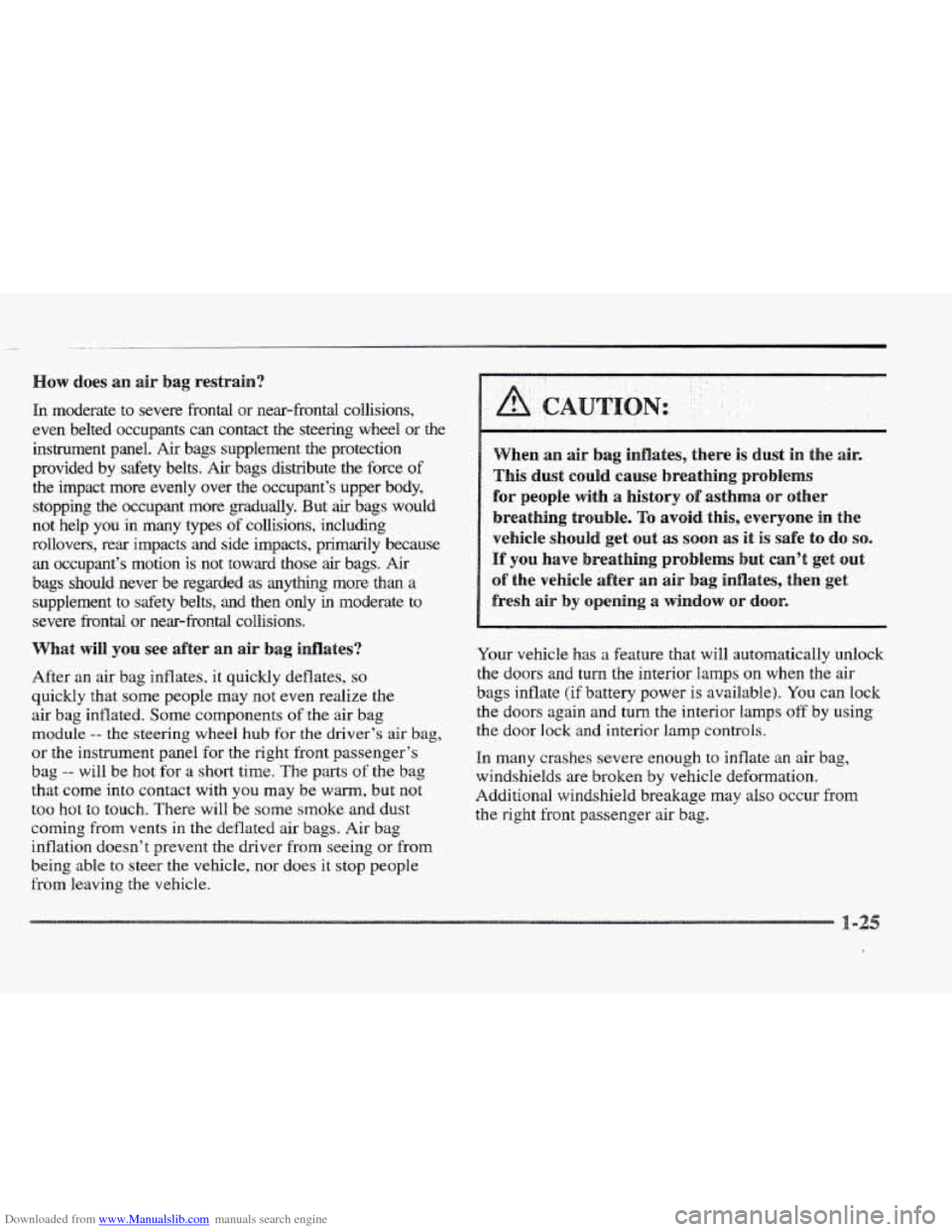
Downloaded from www.Manualslib.com manuals search engine ow does an air bag restrain?
In moderate to severe frontal or near-frontal collisions,
even belted occupants
can contact the steering wheel or the
instrument panel.
Air bags supplement the protection
provided by safety belts.
Air bags distribute the force of
the impact more evenly over the occupant’s upper body,
stopping the occupant more gradually. But air bags would
not help you
in many types of collisions, including
rollovers, rear impacts and side impacts, primarily because
an occupant’s motion is not toward those air bags. Air
bags should never be regarded
as anything more than a
supplement to safety belts,
and then only in moderate to
severe frontal or
near-frontal collisions.
What will you see after an air bag inflates?
After an air bag inflates, it quickly deflates, so
quickly that some people may not even realize the
air bag inflated. Some components of the air bag
module
-- the steering wheel hub for the driver’s air bag,
or the instrument panel for
the right front passenger’s
bag
-- will be hot for a short time. The parts of the bag
that come into contact with
you may be warm, but not
too hot
to touch. There will be some smoke and dust
coming from vents in the deflated air bags. Air bag
inflation doesn’t prevent the driver from seeing or from
being able to steer the vehicle,
nor does it stop people
from leaving the vehicle.
When an air bag inflates, there is dust in the air.
s dust could cause breathing probliems
for people with a history of asthma or other
breathing trouble.
To avoid this, everyone in the
vehicle
should get out as soon as it is safe $0 do so.
If you have breathing problems but can’t get out
of the vehicle after an air bag inflates, then get
fresh ah by OpeniIlg a WhdoW Or door*
Your vehicle has a feature that will automatically unlock
the doors and turn the interior lamps on when the air
bags inflate (if battery power is available). You can lock
the doors again and turn the interior
lamps off by using
the door lock and interior lamp controls.
In many crashes severe enough to inflate an air bag,
windshields are broken by vehicle deformation.
Additional windshield breakage may also
QCCUI- from
the right front passenger air bag.
Page 60 of 361
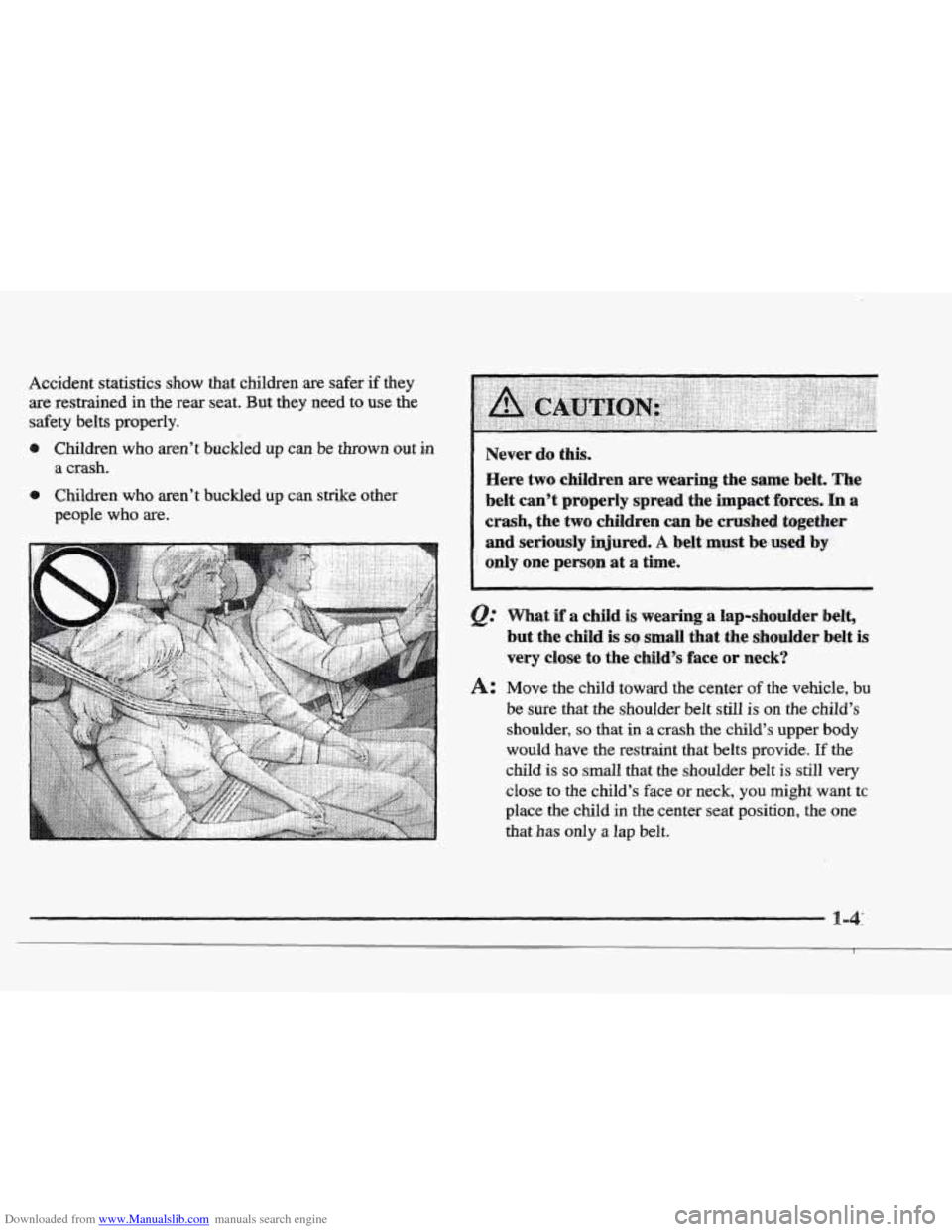
Downloaded from www.Manualslib.com manuals search engine Accident statistics show that children are safer if they
are restrained in the rear seat. But they need to use the
safety belts properly.
e Children who aren’t buckled up can be thrown out in
0 Children who aren’t buckled up can strike other
a crash.
people
who are.
Never do this.
Here two children are wearing the same belt. The
belt can’t properly
spread the impact forces. In a
crash, the
two children can be crushed together
and seriously injured. A belt must be used by
only one person at a time.
~~~~~ ~. ~
@ What if a child is wearing a lap-shoulder belt,
but the child
is so .small that the shoulder belt is
very close to the child’s face or neck?
A: Move the child toward the center of the vehicle, bu
be sure that the shoulder belt still is on the child’s
shoulder, so that in a crash the child’s upper body
would have the restraint that belts provide.
If the
child is so small that the shoulder belt is still very
close to the child’s face or neck, you might want tc
place the child
in the center seat position, the one
that has
only a lap belt.
I
Page 82 of 361
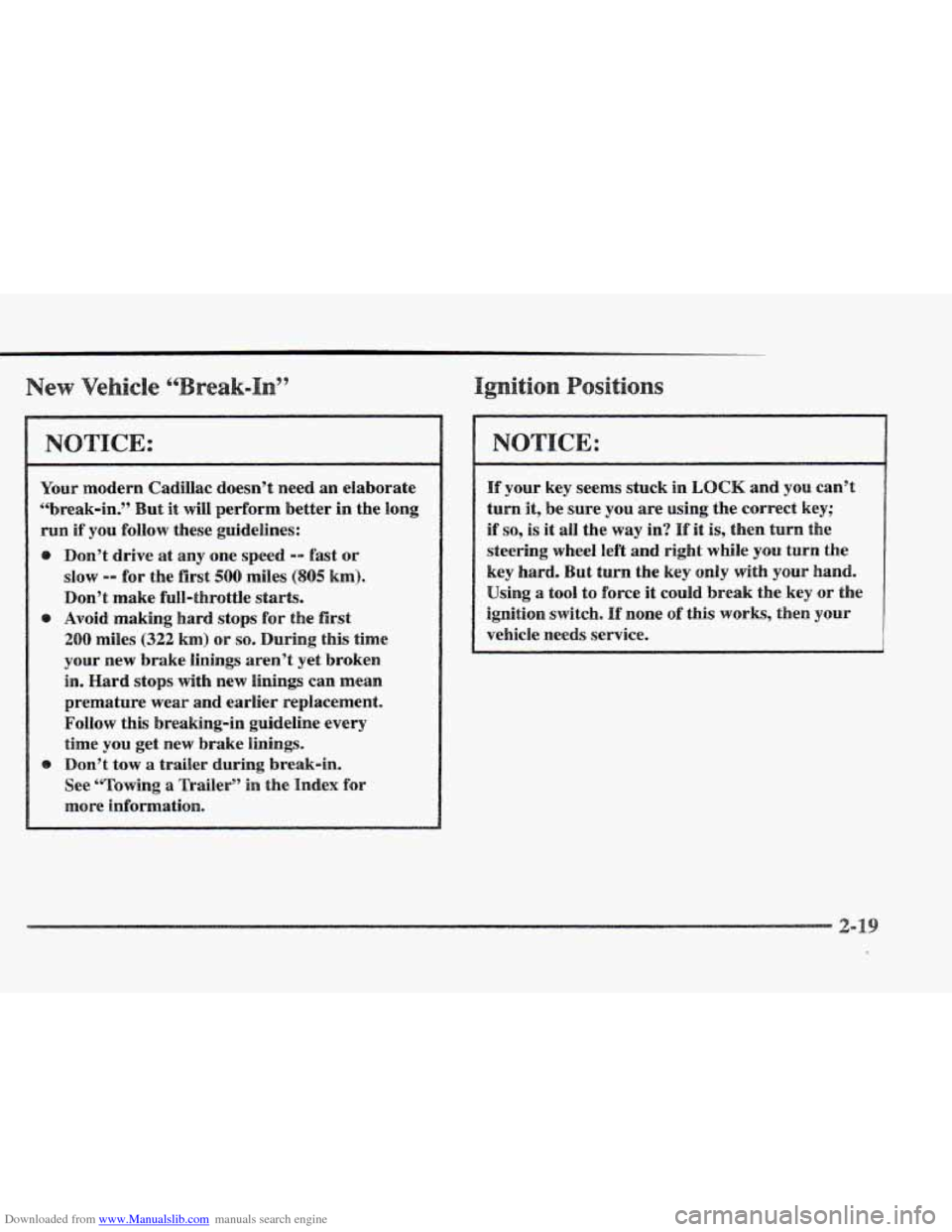
Downloaded from www.Manualslib.com manuals search engine e 99
~~~~~~~~ ~
Your modern Cadillac doesn’t need an elaborate
“break-in? But
it will perform better in the long
run if you follow these guidelines:
cb
Don’t drive at any one speed -- fast or
slow
-- for the first 508 miles ($05 hm).
Don’t make full-throttle starts.
Avoid making hard stops
for the first
200 miles (322 km) or so. During this time
your new brake linings aren’t yet broken
in. Hard stops with new linings can mean
premature wear
and earlier replacement.
Follow this breaking-in guideline every
time you get new brake linings.
Donst tow a trailer during break-in.
See “Towing a Trailer” in the Index for
more
information.
si s
If your key seems stuck in LOCK and YOU canst
turn it, be sure you’are using the correct key;
if so, is it all the way in? If it is, them turn the
steering wheel left and right while
you turn the
bey hard. But turn the key only with your hand.
Using a tool to force it odd break the key OF the
ignition switch.
If none OF this works, then your
vehicle needs service.
Page 83 of 361
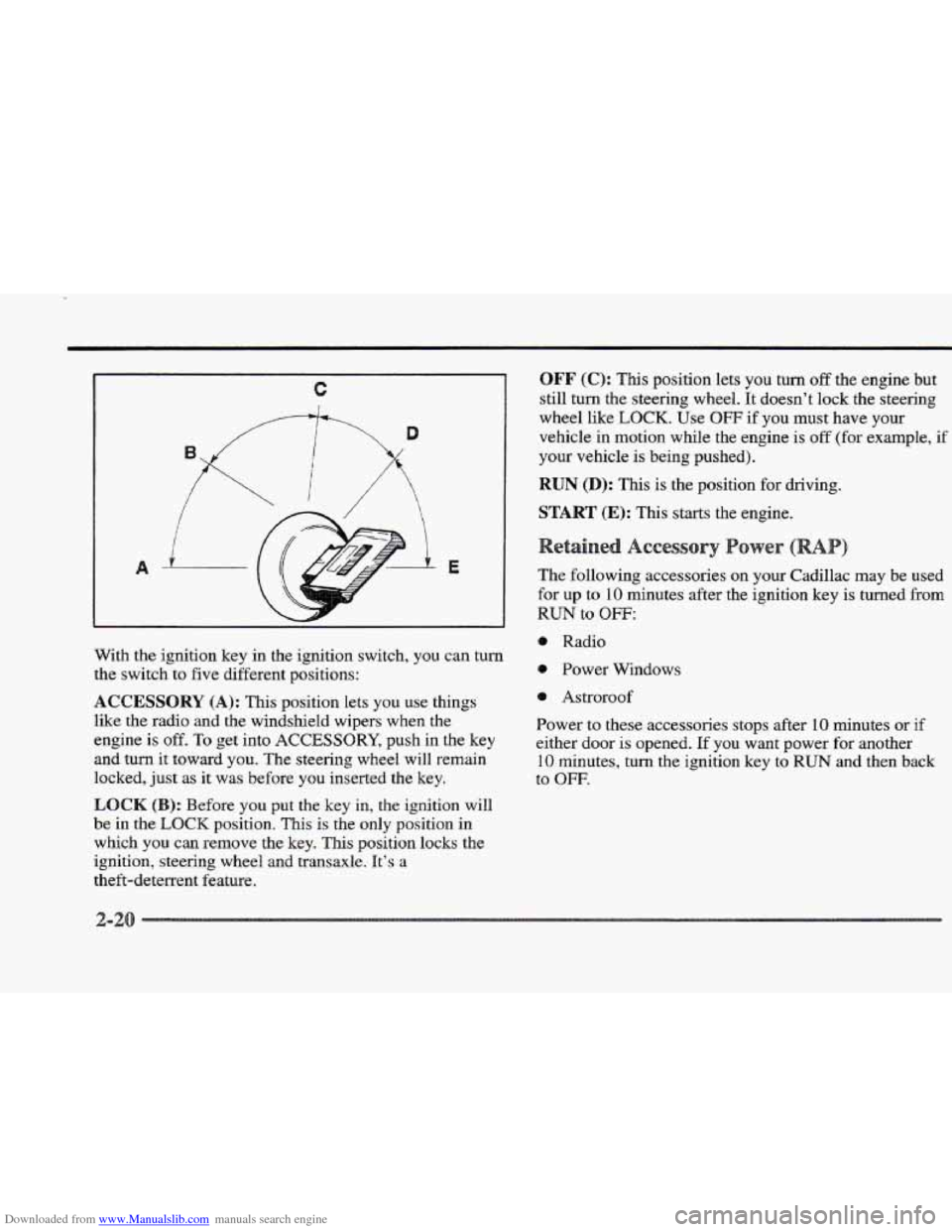
Downloaded from www.Manualslib.com manuals search engine c
With the ignition key in the ignition switch, you can turn
the switch
to five different positions:
ACCESSORY (A): This position lets you use things
like the radio and the windsheld wipers when the
engine is off.
To get into ACCESSORY, push in the key
and turn it toward you. The steering wheel will remain
locked, just as it was before you inserted
the key.
LOCK (B): Before you put the key in, the ignition will
be
in the LOCK position. This is the only position in
which you can remove the key. This position locks the
ignition, steering wheel and transaxle.
It’s a
theft-deterrent feature.
OFF (C): This position lets you turn off the engine but
still
turn the steering wheel. It doesn’t lock the steening
wheel like
LOCK. Use OFF if you must have your
vehicle
in motion while the engine is off (for example, if
your vehicle is being pushed).
RUN (D): This is the position for driving.
START (E): This starts the engine.
Accessory
The following accessories on your Cadillac may be used
for up to 10 minutes after
the ignition key is turned from
RUN to OFF:
@ Radio
e Power Windows
@ Astroroof
Power to these accessories stops after
10 minutes or if
either door is opened. If you want power for another
10 minutes, turn the ignition key to RUN and then back
to OFF.
Page 84 of 361
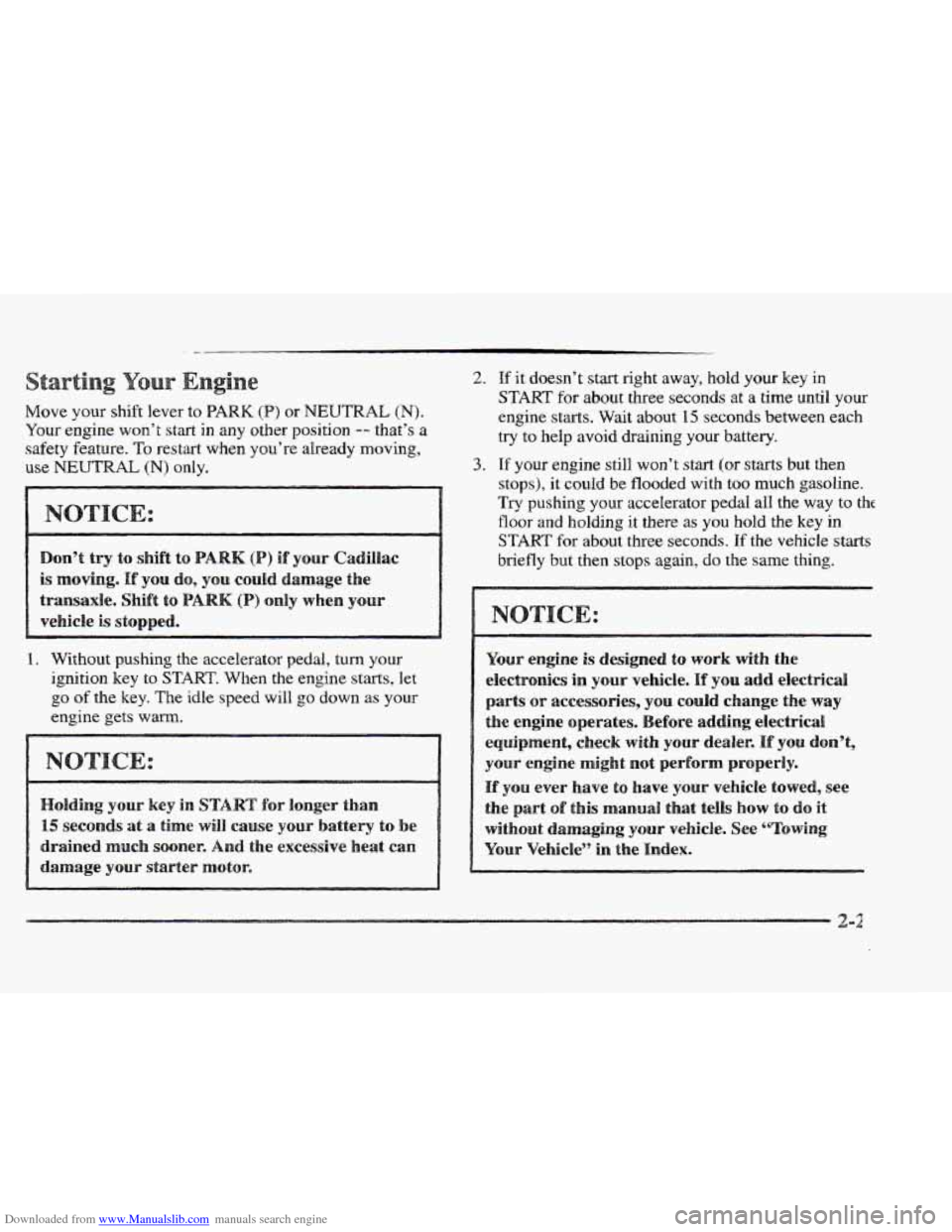
Downloaded from www.Manualslib.com manuals search engine Move your shift lever to PARK (B) or NEUTRAL (N).
Your engine won’t start in any other position -- that’s a
safety feature. To restart when you’re already moving,
use NEUTRAL (N) only.
a e
Don9$ try t0 shift &O (P) if YOUr CadihC
is moving. If you do, you could damage the
transaxle. Shift to PARK (P) only when your
vehicle is stopped.
1. Without pushing the accelerator pedal, turn your
ignition key
to START. When the engine starts, let
go of the key. The idle speed will1 go down as your
engine gets warm.
2. If ,it doesn’t start right away, hold your key in
START for about three seconds at a time until your
engine starts.
Wait about 15 seconds between each
try to help avoid draining your battery.
3. If your engine still won’t start (or starts but then
stops),
it could be flooded with too much gasoline.
Try pushing your accelerator pedal all the way to thc
floor and holding it there as you hold the key in
START for about three seconds. If the vehicle starts
briefly but then stops again, do the same thing.
e 0
Your engine is designed 80 work with the
electronics
in your vehicle. Hf YOU add electrical
parts or accessories, you could change the way
the engine operates. Before adding electrical
equipment, check with your dealer. If YOU don’t,
your enginme might not perform properly.
the part of this manual that teh how t~ do it
Your Vehicle” in the Index.
IF you ever have to have your vehicle towed, see
without damaging your vehicle. See “Towing
Page 86 of 361
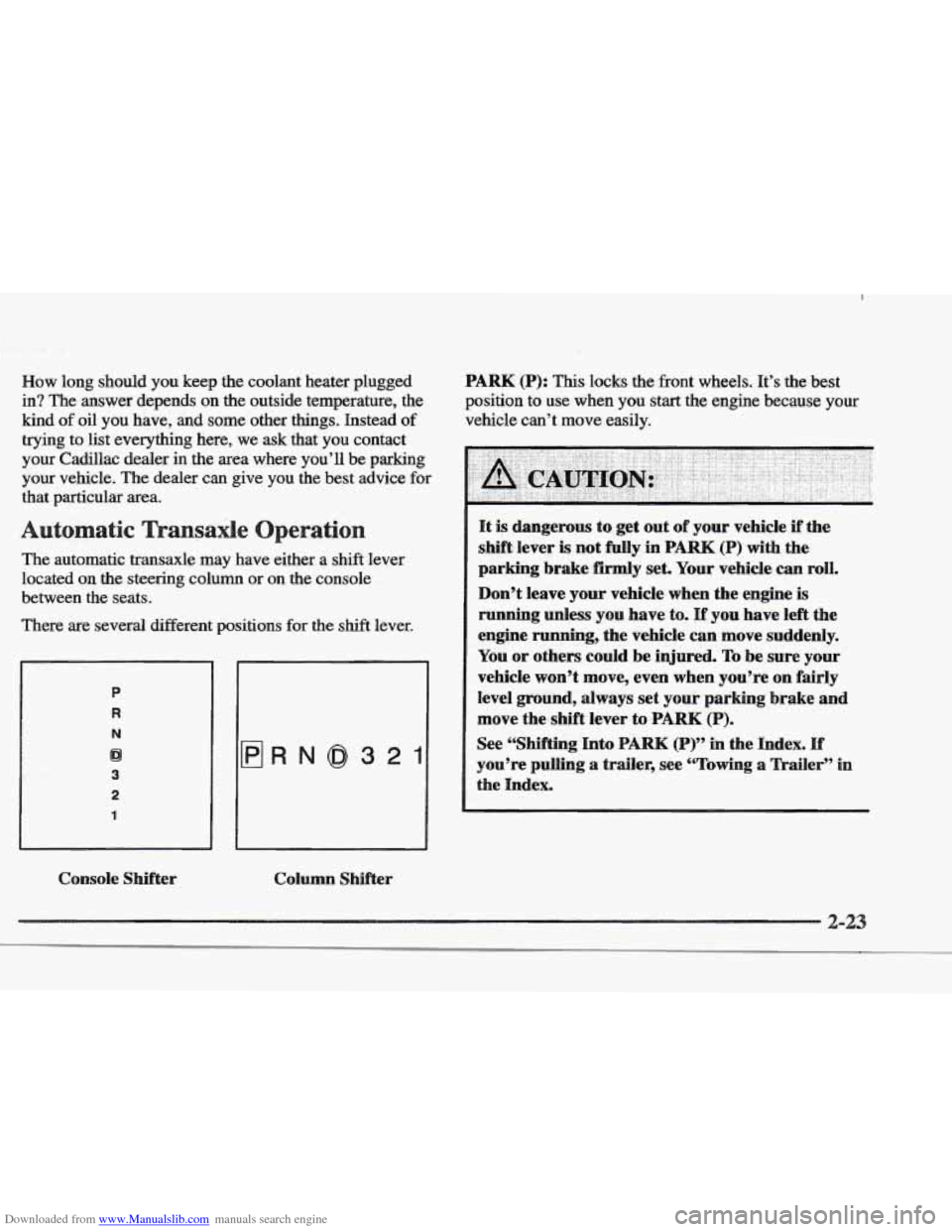
Downloaded from www.Manualslib.com manuals search engine How long should you keep the coolant heater plugged
in? The answer depends on the outside temperature, the
kind
of oil you have, and some other things. Instead of
trying to list everything here, we ask that you contact
your Cadillac dealer in the area where you’ll be parking
your vehicle. The dealer can give you the best advice for
that particular area.
The automatic transaxle may have either a shift lever
located on the steering
column or on the console
between
the seats.
There are several different positions for the
shift lever.
P
R
N
Dl
3
2
1
HRN@321
Console Shifter Collnmn Shifter PARK
(P): This locks
the.front wheels. It’s the best
position to use when you start the engine because your
vehicle can’t move easily.
It is dangerous to get out of your vehicle if the
shift lever
is not fully in PARK (P) with the
parking brake firmly set. Your vehicle
can roll.
Don’t leave your vehicle when the engine
is
running unless you have to. If you have left the
engine running, the vehicle can move suddenly.
You
or others could be injured. To be sure your
vehicle won’t move, even when you’re on fairly
leveI ground, always set your
parking brake and
move the shift lever to
PARK (P).
See “Shifting Into PARK (P)” in the Index. If
you’re pulling a trailer, see “Towing a Trailer” in
the Index.
2-23
Page 87 of 361

Downloaded from www.Manualslib.com manuals search engine Ensure the shift lever is fully in PARK (P) range before
starting the engine.
Your Cadillac has a brake-transaxle
shift interlock.
You have to fully apply your regular
brakes
before you can shift from PARK (P) when the
ignition key is in the RUN position. If you cannot shift
out
of PARK (P), ease pressure on the shift lever -- push
the shift lever all the way
into PARK (P) and release the
shift lever button
QII the floor shift console models as
you maintain brake application. Then move the shift
lever into the gear
you wish. (Press the shift lever button
before moving the shift lever on floor shift console
models.) See “Shifting Out
of PARK (P)” in this section.
EVERSE (It): Use this gear to back up.
Also use this gear to J-QC~ your vehicle back and forth to
get out of snow, ice or sand without damaging your
transaxle. See “If You’re Stuck in Sand, Mud, Ice or
Snow” in the Index for additional information.
NEUTRAL (N): In this position, the engine
doesn’t connect with
the wheels. To restart when you’re
already moving, use
NEUTRAL (N) only. Also, use
NEUTRAL (N) when your vehicle is being towed.
Shifting out of PARK (P) or NEUTWAL (N) while
your engine
is “racing” (running at high speed) is
dangerous. Unless your foot is firmly on the
brake pedal, your vehicle coulld move very
rapidly.
You could lose control and hit people or
objects. Don’t shift
out of PARK (P) or
NEUTRAL (N) while your engine is racing.
Damage to your transaxle caused by shifting out
of PARK (P) or NEWTML (N) with the engine
racing isn’t covered by your warranty.